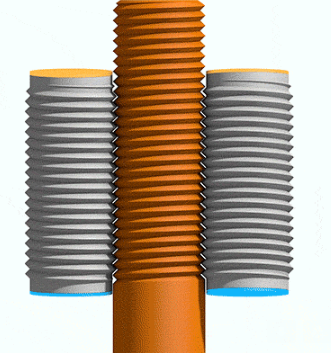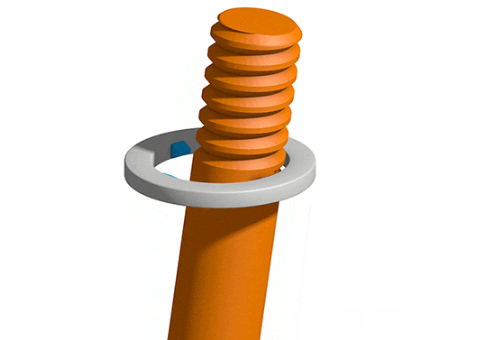How to Make a Lead Screw

How does the production of lead screws actually work? What processes exist and what is the difference between them? First, we should compare the two manufacturing methods used to manufacture all lead screws.
How to Make a Lead Screw via Thread Rolling
The manufacturing process known as thread rolling adheres to the forming process according to DIN 8580. Unlike thread whirling, which we will discuss below, thread rolling involves absolutely zero cutting.
Manufacturing a lead screw via the thread rolling method is actually quite simple in principle: A metal shaft is placed in the middle between two tools that have a certain thread profile. These tools rotate at the same time and the thread is rolled into the surface of the raw material through a process known as cold forming. The thread profile is transferred to the work piece through compressive stress and rotation, and is then ready to be used in an application!
Here’s a visual of the thread rolling process:

Advantages:
- With large quantities, this manufacturing process is faster and cheaper than thread whirling, mostly because there is a lower material requirement.
- Cold forming also hardens the surface and thus achieves greater strength.
- The lead angle, the high surface quality of the rolled thread and the low coefficient of friction of the plastics lead to high efficiency and a long service life of the spindle drive.
Our lead screws can be easily designed online using our lead screw designer. In just a few steps, you can download the CAD data, including the production drawing, free of charge—CAD software or experience using CAD programs is not required. igus® also offers a wide range of lead screw options in the online lead screw shop.
How to Make a Lead Screw via Thread Whirling
Now, let's take a look at the second type of lead screw manufacturing—thread whirling. Once again, the actual manufacturing process can be simply explained in principle: In contrast to thread rolling, thread whirling only requires one tool, which is ring-shaped and clamped around the corresponding work piece. This tool then rotates very slowly while the whirling tool rotates on the outside at a very high speed. The thread pattern is carved into the work piece via inward cutting tools. For a better visual of the process, look below:

Advantages:
- This process is ideal for producing very precise threads that require a particularly high surface quality. This means that the surface is rougher than the thread rolling and the edges sharper.
- The flexibility makes it suitable for a wide variety of thread geometries.
- The process is often used for materials that are not or only poorly suited for thread rolling.
Final Thoughts on How to Make A Lead Screw
Both processes have their special properties, but igus® utilizes thread rolling as the standard method due to the cost savings, the better surface hardening, and the longer service life. Thread whirling is still the more suitable method for small quantities and very precise threads that require tight tolerances. However, determining the exact lead screw always comes down to your application and its specific requirements.
If you would like to speak to an expert about your particular application requirements, please do not hesitate to contact a lead screw systems specialist here. You can also visit our website, or call us at 800-521-2747.



